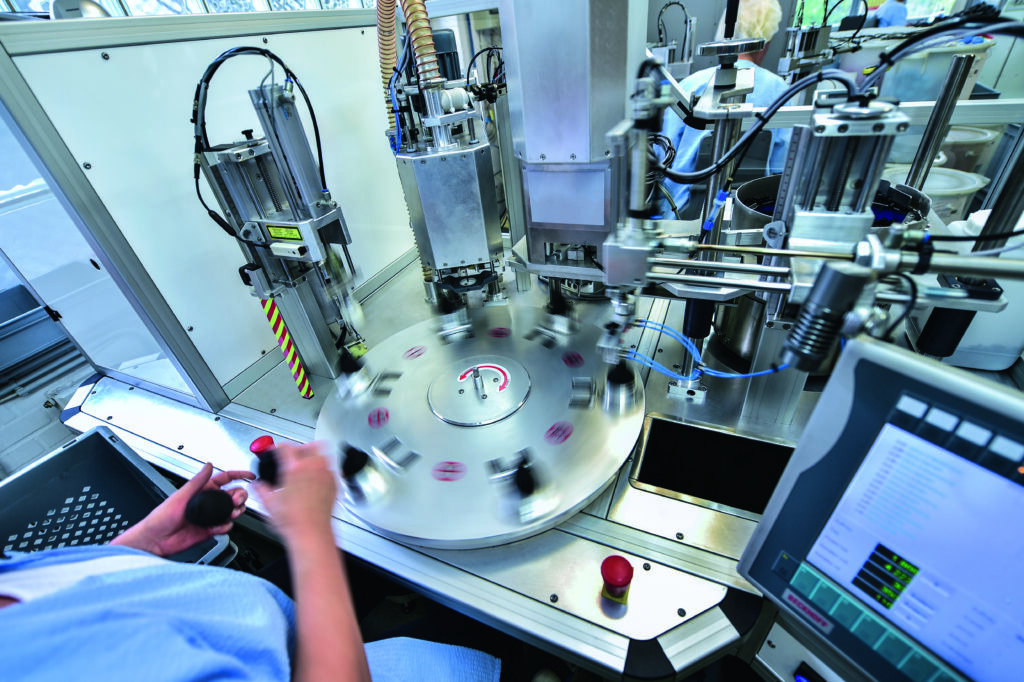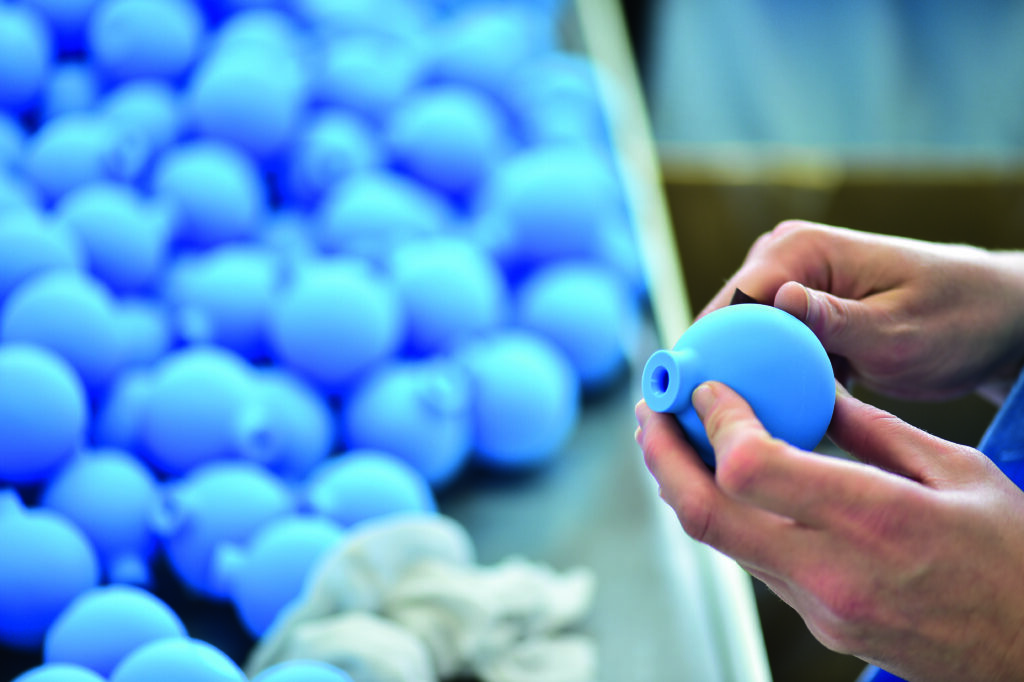We are passionate about technology and what innovation can bring to the future.
Since our early beginnings, our focus has been on developing leading-edge technology to obtain the best, high-quality hand pumps and components when other manufacturing methods, such as injection-, dip- or blow-molding, are unreliable or simply not functional.

We Can Manufacture All Types of Products to Your Exact Specifications
Rotational molding is a manufacturing process used to create hollow, seamless plastic products by heating and rotating a mold filled with liquid or powdered material. For soft PVC, this method allows for flexible, durable, and smooth-surfaced items.
Examples of soft PVC products made with rotational molding:
- Hand Pumps – Blood Pressure Bulbs
- Ear Syringes – Squeezable and durable
- Pump Bulbs – suction and deflation pumps.
Injection molding for plastics is a manufacturing process where molten plastic is injected into a mold under high pressure, then cooled and solidified into a precise shape. It is widely used for producing high-volume, detailed, and consistent plastic parts with minimal waste.
Common Plastics Used in Injection Molding:
- ABS (Acrylonitrile Butadiene Styrene) – Strong, impact-resistant (e.g., automotive parts, housings).
- PP (Polypropylene) – Lightweight, chemical-resistant (e.g., containers, medical components).
- PE (Polyethylene – HDPE/LDPE) – Flexible, durable (e.g., bottles, pipes).
- PC (Polycarbonate) – Transparent, high-strength (e.g., eyewear lenses, protective covers).
- Nylon (PA – Polyamide) – Wear-resistant, tough (e.g., gears, mechanical parts).
- POM (Polyoxymethylene, Acetal) – Low-friction, rigid (e.g., precision gears, fasteners).
- PS (Polystyrene) – Rigid or foam (e.g., packaging, disposable cutlery).
- TPU (Thermoplastic Polyurethane) – Flexible, rubber-like (e.g., phone cases, seals).
Applications:
- Automotive: Dashboards, bumpers, clips.
- Medical: Syringes, surgical instruments.
- Consumer Goods: Toys, containers, electronics housings.
- Industrial: Machine components, electrical connectors.
Compression molding is a manufacturing process where a pre-measured amount of plastic material (often in the form of a preheated sheet, granules, or powder) is placed into an open mold cavity. The mold is then closed and subjected to heat and pressure, forcing the material to conform to the mold shape. Once cooled, the part is removed, resulting in a strong, durable product with minimal waste.
Common Plastics Used in Compression Molding:
Thermosetting Plastics:
- Phenolic Resins (Bakelite) – Heat-resistant, used for electrical components.
- Epoxy Resins – Strong, rigid, used for aerospace and automotive parts.
- Melamine & Urea Formaldehyde – Scratch-resistant, used in kitchenware and electrical casings.
- Polyester (BMC, SMC) – High-strength, used in automotive and industrial applications.
Thermoplastics:
- Rubber (e.g., Silicone, EPDM) – Flexible, used for seals and gaskets.
- PEEK (Polyetheretherketone) – High-performance, used in medical and aerospace.
Applications:
- Automotive: Body panels, brake pads, engine covers.
- Electrical: Switchgear components, insulating parts.
- Consumer Goods: Cookware handles, dinnerware, gaskets.
- Medical: Prosthetic components, dental trays.
Blow molding is a manufacturing process used to create hollow plastic parts by inflating a heated plastic tube (parison) inside a mold until it takes the desired shape. This method is ideal for producing lightweight, seamless, and high-volume hollow objects.
Common Plastics Used in Blow Molding:
- HDPE (High-Density Polyethylene) – Strong, chemical-resistant (e.g., detergent bottles, fuel tanks).
- LDPE (Low-Density Polyethylene) – Flexible, impact-resistant (e.g., squeeze bottles, plastic bags).
- PP (Polypropylene) – Lightweight, heat-resistant (e.g., medical containers, automotive reservoirs).
- PET (Polyethylene Terephthalate) – Transparent, durable (e.g., water and soda bottles).
- PVC (Polyvinyl Chloride) – Chemical-resistant, flexible (e.g., medical tubing, industrial containers).
Applications:
- Packaging: Bottles for beverages, household cleaners, and personal care products.
- Automotive: Fuel tanks, air ducts, washer fluid reservoirs.
- Medical: IV bags, pharmaceutical bottles.
- Industrial: Large storage drums, chemical containers.
Applications of Electronics:
- Consumer Electronics: Electric Ear Syringes, Electric Nasal Aspirators
- Medical Electronics: DVT Pumps, Tens
RF (Radio Frequency) Welding, also known as high-frequency (HF) welding, is a process that uses electromagnetic energy to heat and fuse thermoplastic materials together. The process works by applying high-frequency radio waves (typically 13–100 MHz) to the material, causing the molecules to vibrate and generate heat. This heat softens the plastic, allowing it to be pressed and bonded under pressure. Once cooled, a strong, uniform weld is formed.
Common Materials Used in RF Welding:
- PVC (Polyvinyl Chloride) – Common for medical bags, inflatable products.
- TPU (Thermoplastic Polyurethane) – Used in waterproof and high-durability applications.
- EVA (Ethylene Vinyl Acetate) – Flexible and resilient for various packaging.
- PET (Polyethylene Terephthalate) & PETG – Used in medical and consumer goods.
Applications of RF Welding:
- Medical: IV bags, blood bags, surgical cushions.
- Automotive: Airbags, seat cushions, protective covers.
- Consumer Goods: Inflatable toys, waterproof gear, tarps.
- Industrial: Conveyor belts, protective clothing, flexible tanks.
RF welding creates strong, airtight, and watertight seals, making it ideal for applications requiring durability and reliability.
Rapid prototyping is a manufacturing process used to quickly create physical models of a design using digital data, typically through additive (3D printing) or subtractive (CNC machining) techniques. It enables fast testing, iteration, and validation of product designs before full-scale production.
Common Rapid Prototyping Methods:
- 3D Printing (Additive Manufacturing) – Layer-by-layer material deposition using FDM, SLA, SLS, or DLP technologies.
- CNC Machining – Fast and precise prototyping using milling or turning on various materials.
- Vacuum Casting – Creating small-batch prototypes using silicone molds.
- Injection Molding (Soft Tooling) – Low-volume molding for functional testing.
- Laser Cutting & Engraving – Quick 2D prototyping of sheets like acrylic or metal.
Applications of Rapid Prototyping:
- Product Development: Early-stage concept models.
- Functional Testing: Evaluating strength, fit, and performance.
- Medical Prototypes: Custom prosthetics, surgical guides.
- Automotive & Aerospace: Fast iteration of complex components.
- Electronics: Enclosures, circuit board housings.

Recently, we introduced a new line of products made from innovative Sarolit™ raw materials, including non-phthalate, fire-retardant and cold-hardy materials. Our extensive line of materials and accessories round out our product offering – ensuring that you have the best, most reliable solution available for your particular application.
Our sole focus every day is on improving our products and expanding our services and lines of business. We want to be your partner for all of your medical, technical or industrial device needs.
If you are interested in learning more about our innovative products and services, contact us today!
